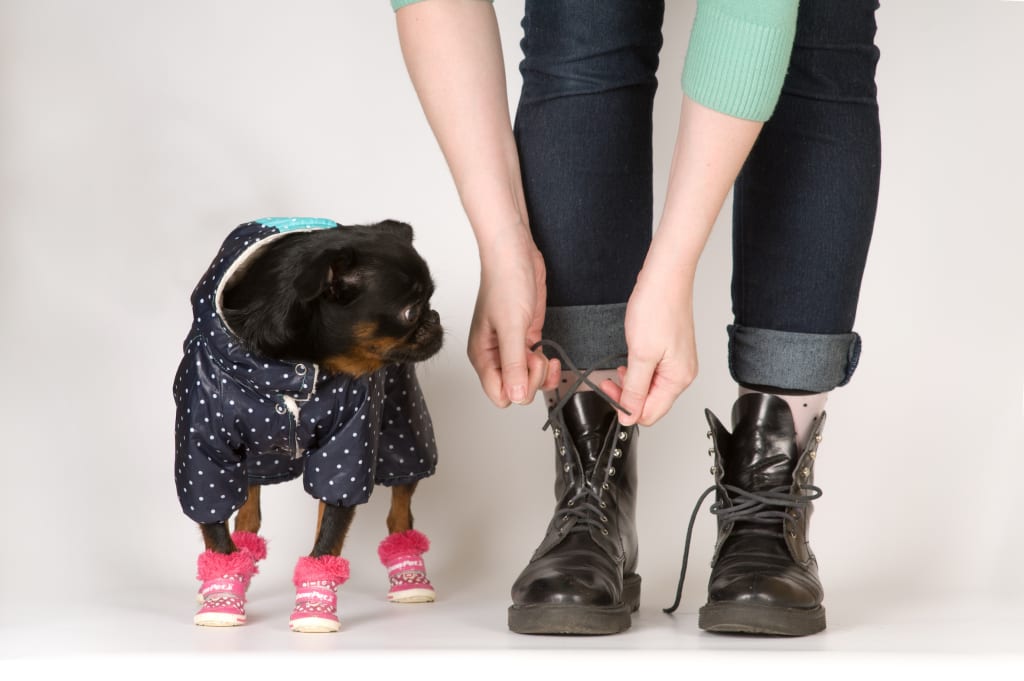 Sir Walter Wally may not have seen his shadow this year, and it may seem as though winter is over but you never can tell for sure, and Old Man Winter may yet have some snow and ice up his sleeve. That means more grit, salt and chemicals on sidewalks and roads, which can be bad news for dogs’ feet.
Sir Walter Wally may not have seen his shadow this year, and it may seem as though winter is over but you never can tell for sure, and Old Man Winter may yet have some snow and ice up his sleeve. That means more grit, salt and chemicals on sidewalks and roads, which can be bad news for dogs’ feet.
If you are planning to head out on a walk and the weather has taken a turn for the worse, then we’ve got tips to help you protect your pup’s pads and keep his feet in good shape–no matter what the mercury does.
Why Winter Is Hard on Dogs’ Feet
There are several reasons why winter can be detrimental to your dog’s foot (and general) health. The first and most obvious problems are road salt and deicer chemicals. These chemicals can burn your furbaby’s feet when he is exposed to them, but they can also cause other kinds of trouble when your dog tries to lick them off. It’s fairly common for dogs who have ingested chemicals in this way to make emergency trips to the vet. Even if the chemicals don’t burn your dog’s feet or poison him, salt can dry out the skin of his feet, which can lead to painful cracking and bleeding.
Ice itself is another problem for dogs’ feet in winter. If the hair between the pads on your dog’s feet is longer, ice can build up in those areas. This eventually creates an “ice ball” that acts the same way as a stone between the pads, causing pain, bruising and limping.
Finally, if it’s very cold outside and your dog is exposed for too long she could get frostbite. This is just as dangerous for dogs as it is for people, and may require surgery.
Tips for Protecting Paws
Whether it’s winter chemicals or snow and ice, it’s always a good idea to take preventive action if you’re planning to be outdoors with your dog this year. Here are several steps you can take to keep your pooch’s feet safe:
- Choose a foot-friendly deicer for sidewalks and paths around your own home. You may not be able to choose what is used on public paths and roads, but you can make your yard safer. Purchase commercial products that are pet-friendly, or you could use kitty litter instead of grit if you don’t have any of those products on hand.
- Paw wax or balm, which is (as the name suggests) a waxy coating that is applied to the feet before a walk is another great way to help prevent damage to your dog’s feet. It forms a protective layer that prevents chemicals from reaching the skin, and as long as it’s applied properly and thoroughly before each walk, it can keep your dog’s feet safe.
- Make sure you trim the hair between the pads and toes if you opt for balm or wax as a protective coating, because long hair on the feet can prevent proper application.
- Booties are another great choice and one of the most effective methods of keeping your dog’s feet safe. Not all dogs will accept booties, but if you get the right style and size and spend some time training your dog to get used to them, they may be the solution you need. Make sure your dog’s nails are well groomed when using booties too, as longer nails inside a bootie can cause painful pressure or other damage.
- Pay close attention to your dog’s feet, and check them after every walk. If you notice any issues for concern, contact your vet and avoid walking very far outdoors until the problem is resolved.
With some planning and a few simple products, you can help keep your dog’s feet safe in the winter. By following these tips, you should find chemicals and ice are not a problem. If all else fails, though, remember that walking on snow or grassy areas rather than on sidewalks and opting for shorter, more frequent walks are also good choices for safe winter exercise.

